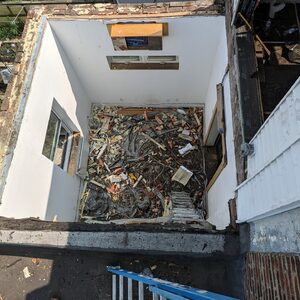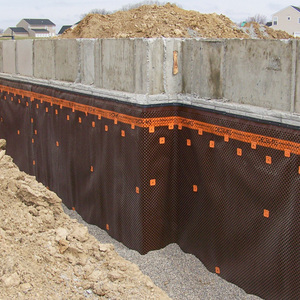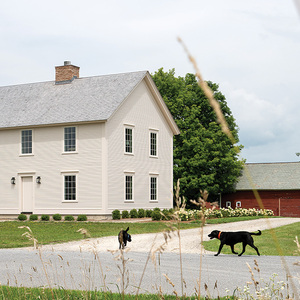*
Manufactures changed from 15lb. felt to “#15” felt about 4 or 5 years ago as they did with 30lb. to #30.
Full weight felts are still available and are known as ASTM rated felts. Although few lumberyards stock the ASTM stock many roofing suppliers/distributors do. Visqueen [polyethelene] sheeting is another product that isn’t full weight anymore but look what happened to the 5 cent candybar, too.
Discussion Forum
Discussion Forum
Up Next
Video Shorts
Featured Story

Key proposals for the next edition of the International Residential Code tackle room sizes, stair specs, emergency egress, and deck guards, among other requirements.
Featured Video
Video: Build a Fireplace, Brick by BrickHighlights
"I have learned so much thanks to the searchable articles on the FHB website. I can confidently say that I expect to be a life-long subscriber." - M.K.
Fine Homebuilding Magazine
- Home Group
- Antique Trader
- Arts & Crafts Homes
- Bank Note Reporter
- Cabin Life
- Cuisine at Home
- Fine Gardening
- Fine Woodworking
- Green Building Advisor
- Garden Gate
- Horticulture
- Keep Craft Alive
- Log Home Living
- Military Trader/Vehicles
- Numismatic News
- Numismaster
- Old Cars Weekly
- Old House Journal
- Period Homes
- Popular Woodworking
- Script
- ShopNotes
- Sports Collectors Digest
- Threads
- Timber Home Living
- Traditional Building
- Woodsmith
- World Coin News
- Writer's Digest


















Replies
*
Here's one for you. A builder is putting up 4 houses on a 5 acre lot at the end of my street. These houses are selling for $700K and up (the agent is listing our house). Drove by today and the first house built and sold had portions of the vinyl siding removed. House is brick front and vinyl on the other three sides. Apparently, someone forgot the housewrap over the OSB before putting on the siding. What is going on here people??? Do the developers have the inspectors in their pockets??? I am appalled! I will be the GC on our new home. Trust, honesty and the american way, we're headed towards anarchy at this rate. Your comments appreciated. Frank
*
Frank,
Around here, and I assume most areas, housewrap is not a code issue. It is a specification item, and I hope to God we never get to the point that every construction decision is predetermined by code.
As a homeowner, it is your duty to know what is in your house specs, and to choose a builder that you know you can trust. And having said that, keeping an eye on your project, so you can clear up any mistakes or misunderstandings, should they occur. Believe me, no inspector is there to see that you have a quality job and good value for your dollar. I've had some rough framing inspections last less than 5 minutes. (Not that I complained)
I don't know what you do for a living, but you better think carefully before you decide to take on the second job of contractor. Do a search on this topic here and you will have some enlightening
information on how risky that is.
John
*Rich,Sorry I didn't notice your post 'til tonite. "Bull" is roofer slang for roof cement. The aluminum starter strip has to be tarred in to the felt, as well as soil stacks, flue pipes, chimneys, etc., before the shingles are applied. Instead of step flashing they use a piece of aluminum bent at a 90 deg. angle,4"-6" on either side of the bend, 8 to 10 ft. long. This is installed against the wall, and the horizontal leg (against the felt) must also be tarred in to the felt. The shingles are then installed over the horiz. flange and up against the verticle flange. Siding or counter flashing is then installed over the verticle flange.Hope I made myself clear, John
*Frank, where is your "HERE"? My "here" is Southern Calif. Four houses on a ONE acre lot is the norm, there are several such in-fill projects around town within the last year. In this area these are $300K to $450K range. There is no such thing as a 1 acre building lot in Orange County, hasn't been for a long time. No vinyl siding on those houses either. Joe H
*CODE HERE REQUIRES 15# FELT UNLESS YOU GO FLATTER THEN 2.50/12 THEN YOU HAVE TO RUN TWO LAYERS OF 15# OR 1 LAYER OF 30. iF YOU GO FLATTER THEN 2/12 THEN YOU RUN ICE AND WATER SHIELD, THEN FELT THEN 3 TAB. that is if you want to run 3 tab that flat. I do not like running any flatter then 3/12. According to our local inspector , two layers of 15 is better then 1 roll of 30. Says it seals around nails better.
*Yes, clear even to me.Thanks,Rich Beckman
*
It has been said that paper punctured by thousands of nails is not exactly the best leak stopper. This is true. I've always heard that that the primary purpose of paper was to act as a moisture barrier to keep the moisture and oils in asphalt and asphalt/fiberglass shingles from leaching in to the roof sheathing and thereby prematurely aging the shingles,and that it was the job of the shingles to keep the water out.
*
A friend of mine recently went to a seminar put on my Owens Corning that focused on their roofing products. OC's recommendation was to use 15# builders felt rather than 30# for fiberglass/asphalt shingle underpayment as the 15# "breaths" better and the roof does not get as hot resulting in longer shingle life. That was the first time I'd heard that one… I like 30# for roofs that will be exposed quite a while before the roofing crew shows up.
Any opinions?
PS: My building supply still does not carry Roofers Select felt, but say that they are considering stocking it.
*Matt, IMHO #15 is almost worthless. I guess it's acceptable if you cover it immediatly with shingles, but as someone who remembers what #15 used to be(ragfelt base, not paper, and a weight that actually was 15 lbs.) what they sell now is junk. I have been using #30 as my normal spec. on roofs for about 11 yrs. now.John
*Matt,
View Image © 1999-2000"The city is not a concrete jungle, it is a human zoo." Charles Wadsworth
*Matt, Florida code calls for shingles to be placed on 15lb felt, but most builder use 30lb for the same reason you posted, to dry in until the roofers shingle. I've never had any problem with inspectors, but I have heard of an inspector with an attitude failing a contractor because "the code calls for 15lb"
*Wow! Thats like failing a rough-in for studs being 12" on center, instead of 16". Incomprehensible! Come to think of it, I have a good friend who roofed in Naples, and he tells me #30 is code down there, all drip edge must be bulled in as well as protrusions, before shingles are applied, and step flashig is not permitted, all because high winds can drive the rain under the shingles and up the step flash.John
*I've never used 15# felt under shingles... but have seen it under afew leaky tear off I've done. Perhaps a coincidence
*nothing wrong with 15# felt, especially on new construction..but for remodeling and tearoffs, we switched to 30# about ten years ago.. and stayed with it until Certainteed's Roofers Select came out.. now we use roofers select for everything that we would have used 15# or 30# for...
*JRS,If you could indulge me, please.> drip edge must be bulled in as well as protrusions, before shingles are applied, and step flashig is not permittedbulled in drip edge? protrusions? I know what drip edge is (the lumberyard here calls it starter), but after that I'm lost.step flashing is not permitted? So what is used in its place?Feeling ignorant (because I am),Rich Beckman
*You guys are rediculous to(o) often....So if they made 1000 pound would that be the way to go?????I have used 15 and none and and 30 and full ice and water shield....all with not a problemo...This discussion is like the one last year when there were several who said they used 3/4" ply for wall sheathing!!!!....Rediculous...waste of money...but if ya sleep betta at night...then to each his own...near the stream havin a hard time not bein mean...aj9
*Manufactures changed from 15lb. felt to "#15" felt about 4 or 5 years ago as they did with 30lb. to #30.Full weight felts are still available and are known as ASTM rated felts. Although few lumberyards stock the ASTM stock many roofing suppliers/distributors do. Visqueen [polyethelene] sheeting is another product that isn't full weight anymore but look what happened to the 5 cent candybar, too.
*I don't do alot of roofing but when I do, it's 30# if it's going to sit exposed for a few days, and 15# if I'm roofing it now. Never had a roof leak.We don't get florida's rain or buffalo's snow and by the time any hurricanes reach us, they've lost all their strengh tearing up the states below us.Why is 30# felt better? Does the 15 let water pass through it?, Will the 15, fall apart under the shingles when the 30# won't?
*Jack, I use 30# because it stands up to the weather better than 15#. With our daily deluges followed by a baking tropical sun, the lighter weight paper just doesn't last. If my roofer dries in for me, he uses 15# and shingles over the same day. He likes it because it lays down with less wringles. It's my understanding that felt paper is used to separate shingles from the wood deck. If your'e depending on felt to stop leaks, get a new roofer.
*I always use 30# felt, but then again, it never gets covered up right away on our jobs...I like it because it is less likely to tear when you are installing it, and lasts a lot longer in the elements. The criticism I remember hearing about felt the most is that it may become brittle over time. To me it seems like the thicker the felt and the more asphalt the better. Plus 30# makes great 1/16" shims for packing stuff out.
*Maybe it's just because I'm a klutz and all, but every thime I've tried to walk in 15# on a steep roof, I've torn it somewhere. Guess what I use?Mike
*Schedule shingle delivery on the last day of roof sheathing, and when you finish the sheathing you switch guns and start nailing down the shingles. If you expect rain and you put in the wood windows already, then felt it with whatever you can get till the rain stops and you can shingle. Put 6 guys up there and you can have 25 squares down in less than a day. I know some want to wait till the plumber gets his stack through but WHY? You can leave a few courses out for a chimney also. (ok , I know everybody wants to be (or hire) a specialist, get a roofer to do it. Carpenters are trained to roof yes?)
*Kind of intersting that when it comes to roofs you all recommend more than code requires but when it's sparky on the job, you want the code minimum. I can sympathize - since I also use 30# the times I have roofed - but it is a little wee bit inconsistent methinks. True, it doesn't add as much as say a switch from romex to emt, but it does add.
*and it's not a required code...i can chose 30 lb. or Roofer's Select as the need may arise.. or if it's new construction..15 lb....i am also not prevented by some arbitraray code from experimenting with new products...like Roofer's Select....
*A felt meeting some minimum standard isn't required by code? I always thought it was. In any case, certainly roofers select and 30# meet the same minimum perforemance tests that 15# must meet to carry that astm marking.
*geeesh bill ..yur a PITA.. where did u lern to read?the 30 # is not required by code , nor some arbitrary rule..i can use it IF i want.. unlike the rules yur discssin as MAY be adopted in yur willage..solve the mystery of the 7/11 stairwell in the 24' house yet?
*To those that scoff at the use of felt paper under shingles:Do you know what "headlap" is? I doubt it. Headlap is the difference between twice the shingle exposure and the total height of the individual shingle.For example. A standard three tab shingle is 12" tall. It is normally laid at a 5" exposure. That leaves 7" of coverage by the next course(course #2). Right?...Wrong! The next course may cover by 7", but the keys(cut-outs that form the tabs) go up another 5". Plus, where the shingles butt together, is not continuously covered. So even keyless shingles have this weak link.The third course covers course #2 by 7" and course #1 by 2". This is the headlap. The weak link in the system is the headlap. If you have a driving rain the water only has to be blown uphill 2" to get under the shingles. On a 12/12 roof this is almost impossible. But on a 4/12 roof this is very likly to happen. Around here we call these roofs "Feltless Wonders". Felt under the shingles is the last line of defense against water.I get anywhere from 5 to 20 calls a year on leaks of this type. It depends on how long and severe our storm season is.So......I guess if you live where there is no rain and no wind then felt is truly unnecessary. For the rest of us, who have to answer to our customers years down the road, we do what we have to do.JohnP.S. I am not suggesting that EVERY roof without felt leaks, only that it unnecessarily increases your chances of a leak. And that's what good roofing practice is all about-minimizing the chances that a roof can leak.
*If 30# felt cost $5000 more than 15, everybody here would use 15. Especially since there is no local group with no real world knowledge of roofing passing rules because they think 30# might be better.
*JRS:The think about headlap is very interesting - I guess I'm easily entertained! :)By the way, here at Breaktime, someone brought up another advantage of felt which is supposedly that it prevents asphalt from the shingles from being absorbed into the roof sheathing and thereby drying out and shortening the life of the shingles. Don't know this for a fact, but it sounds plausible to me.
*
Josh,
I agree with nick. No way does felt "seal around the nails"- #15 or #30, one layer or two. Ice & Water shield is the product you want to use for that purpose.
John